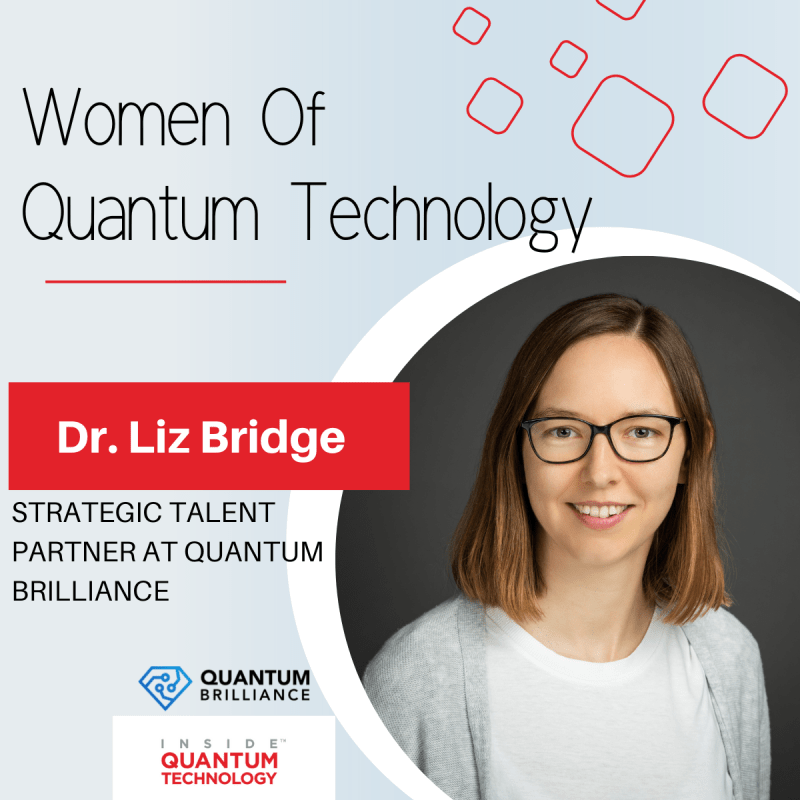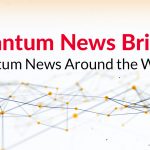Women of Quantum Technology: Dr. Liz Bridge of Quantum Brilliance

For individuals transitioning from research to a job in the industry, the journey can be perceived to be quite tricky. “I have gone through that process myself, and at first glance, it can appear a little daunting to gain knowledge of what the outside world looks like, and how to take those steps,” said Dr. Liz Bridge, a Strategic Talent Partner for Quantum Brilliance, a quantum computing company developing room-temperature hardware using synthetic diamonds. Though Bridge’s main role at Quantum Brilliance is to engage with talent, she is also passionate about creating a smooth transition for individuals moving from research to industry. “There are not many people you can automatically go to to get advice for this,” she explained. “I was going through this journey myself of wondering, how do I find an interesting job in the industry? What are the skills that I have that are useful for them? Earlier, I had no concept of what it is like to work at a company or to work with engineers. I thought I would like to help other people go through this process as well.” Inspired by her own journey, Bridge collaborated with members of ARC Centers of Excellence at the University of Queensland to help create resources for individuals in similar positions. While she has successfully placed herself in the quantum industry, Bridge continues to help others complete this transition successfully. As she explained: “we’re actively doing that part of the journey of reaching out to Ph.D. student groups or postdocs or early career researchers and saying ‘this is what a job in the industry looks like.’ Or I give talks about: ‘What’s it like to join a quantum startup?'”
Before her position at Quantum Brilliance, Bridge had years to feed her passion for quantum science. “When I was at university, I started with natural sciences thinking about doing physics but wasn’t really sure,” Bridge said. “Physics can be perceived as a daunting subject. Everyone knows it’s hard. But at the same time, I really enjoyed it so I thought: ‘I can do that;’ and then transferred from the natural sciences into physics.” Bridge found herself naturally drawn to quantum physics, specifically the systems that make up atomic clocks. Bridge studied these special clocks during her Ph.D. while at the National Physical Laboratory in London. “I liked the idea that I could create something that’s then going to be useful to people,” she added.
After completing her Ph.D., Bridge spent nine years as a postdoctoral researcher at multiple universities before finally finishing at the University of Queensland in Australia. Having spent so much time on these in-depth research projects only for them to end seemed unsatisfying for Bridge as she calculated her next steps. “I started to look around for quantum technology companies, which, fortunately, in the last few years the numbers of those have grown significantly,” Bridge said. “And then I was super lucky to find Quantum Brilliance. My family situation meant I had to stay in southeast Queensland because my partner has a daughter who lives here. Quantum Brilliance is based in Canberra, Sydney and Melbourne (plus two sites in Germany), but I reached out anyway and during the interview process they scoped out a role that could work for me to stay where I am.”
Though she’s no longer in a lab, Bridge continues to use her scientific expertise to find the right talent for the company. “I’m using my technical understanding from my research experience to help the company by firstly scoping out roles internally,” Bridge said. “So, working with hiring managers and teams to say: ‘Who do we need in the team? What are the skills gaps of the current team? Where might we find people with these skills?’ I work with everyone involved, running the interview process to scope out the best fit for the individual, the team and the role, and work closely with the new team member to incorporate them into their new position.” As the quantum industry is currently dealing with a talent shortage, Bridge often finds herself “head-hunting” for talent as well. According to Bridge: “Not everyone is going to walk through the door and say: ‘Hi I’m here and I love quantum physics.’ Sometimes we have to go find them.” With her experience in head-hunting, Bridge recommends some important hiring practices to help to continue to bring in talent. “We’re asking people to use the understanding and expertise and things they can do, and then work closely with others to build up that collective expertise within the team,” Bridge stated. “So, the artificial intelligence community went through this a couple of years back where again, there weren’t a lot of experts in artificial intelligence, and it was about building that expertise in that community. Now that field is more established. Quantum is going through a similar thing right now.”
Besides the general shortage of talent, Bridge cites other challenges that can be hard to connect with the right candidates. “A lot of people we would like to connect with at certain universities or in research groups don’t necessarily have a LinkedIn profile,” she said. “And perhaps that’s because they’re not thinking outside the university arena or they don’t know how to make themselves available to the people outside.” To that end, Bridge offers some simple advice: “Having your profile on your university group is really vital for getting you noticed but the easiest way for people to get found is through LinkedIn. It’s a lot easier to reach out on that.”
Because her job at Quantum Brilliance entails connecting with new talent, Bridge is in a unique position to encourage more inclusivity from both research and industry. “To have a more diverse workforce, the initiative really needs to come from the top,” Bridge said. “You have to have people in the company, especially executives who really believe that diversity is important for their company and for the success of their company.” For Bridge, this initiative needs to go beyond the moral obligation. “It’s not just the moral obligation part,” she explained. “There’s so much data out there to show that a highly diverse team is much more successful. They come up with better ideas, they’re more creative. So, if you’re not putting effort into diversity and inclusion, you’re deliberately making yourself a second-rate company to some extent.”
Bridge also believes that company policies and infrastructure are also crucial in attracting and maintaining a diverse workforce. “So, making sure you’ve got an inclusive environment, that there are flexible and remote working opportunities,” Bridge said. “For example, it’s important to make sure the company has equal parental leave rights. If they’re saying that women get to take more time when they have a child than men do, we’re propagating the idea that women are the primary caregivers and men are the primary workers. The people in the company play a role too in developing these policies. It’s very important to stick your hand up and say, ‘Could we look at having such and such a policy?'” Having the executives work with the company culture and policies can help set up an inclusive environment that helps maintain itself in sustainable and productive ways.
Outreach and the industry’s culture is the third factor in boosting inclusivity and diversity. According to Bridge: “It’s this perception that physics and quantum physics is very hard. And as a generalized rule, women tend to have a bit more of a confidence deficit then men. So, helping people just to overcome that little barrier, I think is really, really helpful. So, I’d encourage people to reach out to either gain a mentor or become a mentor. And anyone can be a mentor, you don’t have to be a senior professor. People really benefit from these little bits of talking through an idea with somebody and just getting that little boost of confidence to put your hat in the ring when you wouldn’t have done otherwise.”
While boosting an individual’s confidence and skill can help, Bridge also believes that companies need more purposeful hiring practices. “Keep the job ad simple,” Bridge explained. “Make sure your job ads are outcome-based rather than naming a long list of skills that are required, also use gender-neutral wording, because both of these practices have been shown to increase the number of women applying for a role. But we’ve also got a responsibility to go out looking for these talented women as well. ” Bridge states “it’s not just gender diversity we should be concerned about, it’s important to consider diversity and inclusion across the board, but that’s a conversation for another interview… ”
Bridge loves speaking to people, especially women, who are passionate about developing their careers in the quantum technology sector. If this article has resonated with you, Bridge is a great person to reach out to and connect with, you can find her on LinkedIn at: https://www.linkedin.com/in/liz-bridge/
Kenna Hughes-Castleberry is a staff writer at Inside Quantum Technology and the Science Communicator at JILA (a partnership between the University of Colorado Boulder and NIST). Her writing beats include deep tech, the metaverse, and quantum technology.



















